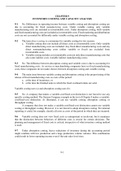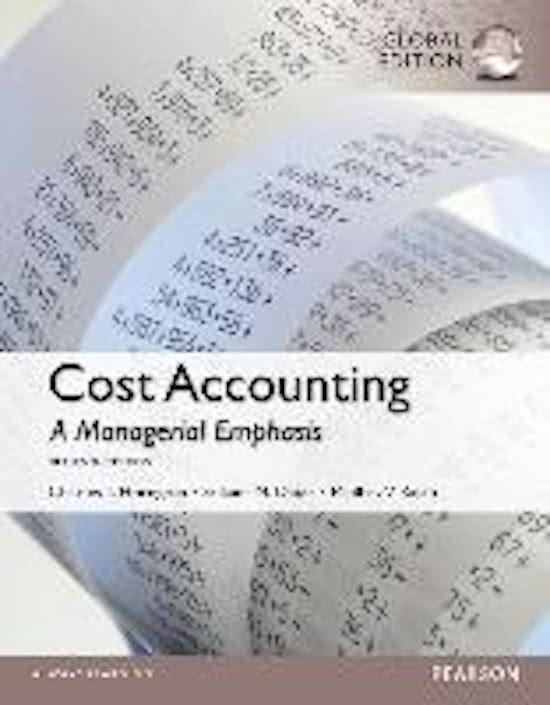CHAPTER 9
INVENTORY COSTING AND CAPACITY ANALYSIS
9-1 No. Differences in operating income between variable costing and absorption costing are
due to accounting for fixed manufacturing costs. Under variable costing, only variable
manufacturing costs are included as inventoriable costs. Under absorption costing, both variable
and fixed manufacturing costs are included as inventoriable costs. Fixed marketing and distribution
costs are not accounted for differently under variable costing and absorption costing.
9-2 The term direct costing is a misnomer for variable costing for two reasons:
a. Variable costing does not include all direct costs as inventoriable costs. Only variable
direct manufacturing costs are included. Any fixed direct manufacturing costs and any
direct nonmanufacturing costs (either variable or fixed) are excluded from
inventoriable costs.
b. Variable costing includes as inventoriable costs not only direct manufacturing costs but
also some indirect costs (variable indirect manufacturing costs).
9-3 No. The difference between absorption costing and variable costs is due to accounting for
fixed manufacturing costs. As service or merchandising companies have no fixed manufacturing
costs, these companies do not make choices between absorption costing and variable costing.
9-4 The main issue between variable costing and absorption costing is the proper timing of the
release of fixed manufacturing costs as costs of the period:
a. at the time of incurrence, or
b. at the time the finished units to which the fixed overhead relates are sold.
Variable costing uses (a) and absorption costing uses (b).
9-5 No. A company that makes a variable-cost/fixed-cost distinction is not forced to use any
specific costing method. The Stassen Company example in the text of Chapter 9 makes a variable-
cost/fixed-cost distinction. As illustrated, it can use variable costing, absorption costing, or
throughput costing.
A company that does not make a variable-cost/fixed-cost distinction cannot use variable
costing or throughput costing. However, it is not forced to adopt absorption costing. For internal
reporting, it could, for example, classify all costs as costs of the period in which they are incurred.
9-6 Variable costing does not view fixed costs as unimportant or irrelevant, but it maintains
that the distinction between behaviors of different costs is crucial for certain decisions. The
planning and management of fixed costs is critical, irrespective of what inventory costing method
is used.
9-7 Under absorption costing, heavy reductions of inventory during the accounting period
might combine with low production and a large production volume variance. This combination
could result in lower operating income even if the unit sales level rises.
9-1
,9-8 (a) The factors that affect the breakeven point under variable costing are
1. fixed (manufacturing and operating) costs.
2. contribution margin per unit.
(b) The factors that affect the breakeven point under absorption costing are
1. fixed (manufacturing and operating) costs.
2. contribution margin per unit.
3. production level in units in excess of breakeven sales in units.
4. denominator level chosen to set the fixed manufacturing cost rate.
9-9 Examples of dysfunctional decisions managers may make to increase reported operating
income are:
a. Plant managers may switch production to those orders that absorb the highest amount
of fixed manufacturing overhead, irrespective of the demand by customers.
b. Plant managers may accept a particular order to increase production even though
another plant in the same company is better suited to handle that order.
c. Plant managers may defer maintenance beyond the current period to free up more time
for production.
9-10 Approaches used to reduce the negative aspects associated with using absorption costing
include:
a. Change the accounting system:
• Adopt either variable or throughput costing, both of which reduce the incentives of
managers to produce for inventory.
• Adopt an inventory holding charge for managers who tie up funds in inventory.
b. Extend the time period used to evaluate performance. By evaluating performance over
a longer time period (say, three to five years), the incentive to take short-run actions
that reduce long-term income is lessened.
c. Include nonfinancial as well as financial variables in the measures used to evaluate
performance.
9-11 The theoretical capacity and practical capacity denominator-level concepts emphasize
what a plant can supply. The normal capacity utilization and master-budget capacity utilization
concepts emphasize what customers demand for products produced by a plant.
9-12 The downward demand spiral is the continuing reduction in demand for a company’s
product that occurs when the prices of competitors’ products are not met, and (as demand drops
further) higher and higher unit costs result in more and more reluctance to meet competitors’
prices. Pricing decisions need to consider competitors and customers as well as costs.
9-13 No. It depends on how a company handles the production-volume variance in the end-of-
period financial statements. For example, if the adjusted allocation-rate approach is used, each
denominator-level capacity concept will give the same financial statement numbers at year-end.
9-14 For tax reporting in the United States, the IRS requires only that indirect production costs
are “fairly” apportioned among all items produced. Overhead rates based on normal or master-
budget capacity utilization, as well as the practical capacity concept, are permitted. At year-end,
9-2
,proration of any variances between inventories and cost of goods sold is required (unless the
variance is immaterial in amount).
9-15 No. The costs of having too much capacity/too little capacity involve revenue opportunities
potentially forgone as well as costs of money tied up in plant assets.
9-16 (30 min.) Variable and absorption costing, explaining operating-income differences.
1. Key inputs for income statement computations are
April May
Beginning inventory 0 150
Production 500 400
Goods available for sale 500 550
Units sold 350 520
Ending inventory 150 30
The budgeted fixed cost per unit and budgeted total manufacturing cost per unit under absorption
costing are
April May
(a) Budgeted fixed manufacturing costs $2,000,000 $2,000,000
(b) Budgeted production 500 500
(c) = (a) ÷ (b) Budgeted fixed manufacturing cost per unit $4,000 $4,000
(d) Budgeted variable manufacturing cost per unit $10,000 $10,000
(e) = (c) + (d) Budgeted total manufacturing cost per unit $14,000 $14,000
(a) Variable costing
April 2014 May 2014
a
Revenues $8,400,000 $12,480,000
Variable costs
Beginning inventory $ 0 $1,500,000
Variable manufacturing costsb 5,000,000 4,000,000
Cost of goods available for sale 5,000,000 5,500,000
Deduct ending inventoryc (1,500,000) (300,000)
Variable cost of goods sold 3,500,000 5,200,000
d
Variable operating costs 1,050,000 1,560,000
Total variable costs 4,550,000 6,760,000
Contribution margin 3,850,000 5,720,000
Fixed costs
Fixed manufacturing costs 2,000,000 2,000,000
Fixed operating costs 600,000 600,000
Total fixed costs 2,600,000 2,600,000
Operating income $1,250,000 $3,120,000
a $24,000 × 350; $24,000 × 520 c $10,000 × 150; $10,000 × 30
b $10,000 × 500; $10,000 × 400 d $3,000 × 350; $3,000 × 520
9-3
, (b) Absorption costing
April 2014 May 2014
Revenues a
$8,400,000 $12,480,000
Cost of goods sold
Beginning inventory $ 0 $2,100,000
Variable manufacturing costsb 5,000,000 4,000,000
Allocated fixed manufacturing costsc 2,000,000 1,600,000
Cost of goods available for sale 7,000,000 7,700,000
Deduct ending inventoryd (2,100,000) (420,000)
Adjustment for prod.-vol. variancee 0 400,000 U
Cost of goods sold 4,900,000 7,680,000
Gross margin 3,500,000 4,800,000
Operating costs
Variable operating costsf 1,050,000 1,560,000
Fixed operating costs 600,000 600,000
Total operating costs 1,650,000 2,160,000
Operating income $1,850,000 $ 2,640,000
a d
$24,000 × 350; $24,000 × 520 $14,000 × 150; $14,000 × 30
b
$10,000 × 500; $10,000 × 400 e
$2,000,000 – $2,000,000; $2,000,000 – $1,600,000
c f
$4,000 × 500; $4,000 × 400 $3,000 × 350; $3,000 × 520
Absorption-costing Variable-costing Fixed manufacturing costs Fixed manufacturing costs
2. – = –
operating income operating income in ending inventory in beginning inventory
April:
$1,850,000 – $1,250,000 = ($4,000 × 150) – ($0)
$600,000 = $600,000
May:
$2,640,000 – $3,120,000 = ($4,000 × 30) – ($4,000 × 150)
– $480,000 = $120,000 – $600,000
– $480,000 = – $480,000
The difference between absorption and variable costing is due solely to moving fixed
manufacturing costs into inventories as inventories increase (as in April) and out of inventories as
they decrease (as in May).
9-4





